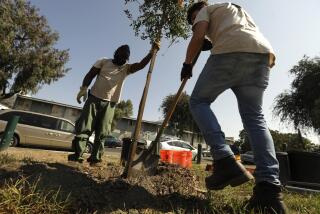REGION : USC, City May Join to Study Labor Pool
- Share via
A group that encourages community members to use city planning to help cure neighborhood ills may join USC in studying the south Los Angeles labor pool.
The South Central/Southeast Task Force--composed of 18 current and former city planners--wants to identify how workers can obtain technical skills.
“Basically we want to look at the types of jobs that will be available in the future to come up with strategies for training,” said Sterling Barnes, a city planning associate and president of the task force. “It’s just one thing we can do to try to lower the unemployment rate in the community.”
RLA, an organization set up to help coordinate rebuilding efforts after the 1992 riots, has also been approached as a possible partner in the study.
While interest in labor issues may seem a far cry from a city planner’s traditional concerns of zoning and compatible land use, Barnes said his group formed precisely because members wanted to broaden their job description.
“Many planners came into planning with the idea of not only being specialists in terms of environmental and land-use analysis but also as advocates for a better community,” said Barnes, who has been with the planning department eight years.
Since its inception in 1987, Barnes’ group has sought to expand the scope of planning to include economic and social considerations. The task force also launched a grass-roots campaign to give south Los Angeles residents more say in city planning.
“There was a general feeling . . . that the Planning Department had given up on south Los Angeles,” he said.
For two years, the task force met outside work to discuss ways the planning process could be used to prevent south Los Angeles from deteriorating.
One of the first steps was the creation of community education workshops.
“We’d tell people if you want child care there is a process to bringing that about,” Barnes said. “We’d offer them steps and strategies to try to promote that.”
In 1989, after a national planners association recognized the group for its work with an award, the task force moved from a volunteer, off-hours group to an official project of the planning department. Impressed with success of the task force, then-department director Ken Topping invited the group to continue its work on city time.
Barnes said task force members are now encouraged to spend up to 10% of their workweek on projects related to the group.
Topping no longer heads the department, but current director Con Howe said the task force has done much to increase planning-related education, not only in neighborhoods but also in the department.
He praised group-sponsored staff lectures and day-to-day interaction with other planners, saying they increased awareness of such issues as nuisance liquor stores and illegal swap meets.
“They help educate the department on what is needed in those communities,” Howe said.
Information: (213) 847-2372.
More to Read
Sign up for Essential California
The most important California stories and recommendations in your inbox every morning.
You may occasionally receive promotional content from the Los Angeles Times.










